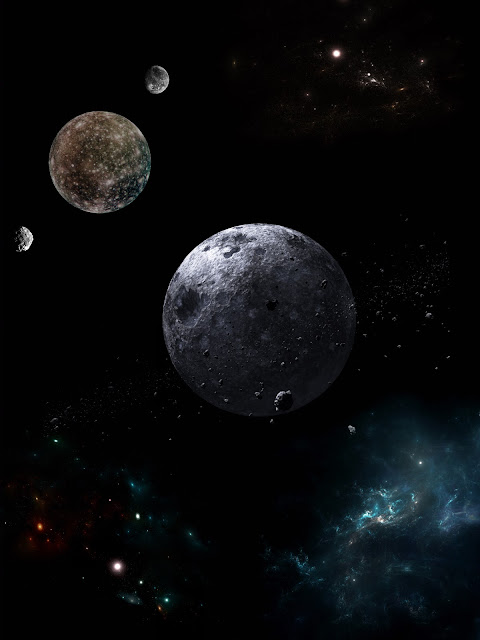Xhorik Secundus is the third planet from the sun of the Xhorik system, after Xhorik Null (never inhabited due to its horrific environment) and Xhorik Prime. It was known as Halovox by the local inhabitants when the Great Crusade reached it and is listed in the official Imperial records as Aeternum, the land of the eternal day. It is slightly larger than Xhorik Prime and has a denser atmosphere. Around 40 million years ago, the planet collided with one of its moons, leaving one face of the planet as a massive crater and greatly slowing the planet's rotation. A single rotation of the planet takes 803 Terran days. A journey around its sun is also relatively slow at approximately 9.3 Terran years. The planet's axis has a tilt so there are very long seasons in addition to the very long days. The minimal centrifugal force of the slower rotation causes objects to feel a bit heavier on Halovox than they otherwise would.
The collision with Xhorik Secundus utterly destroyed the moon and the result is a large, heavy asteroid belt in a close orbit around the planet. This mass of debris results in fairly frequent occurrences of meteoroids entering the atmosphere and either burning up or striking the planet's surface. It also makes passage to and from the planet's surface dangerous, especially for larger vessels unless they are heavily shielded or fitted with suitable weapons for clearing the debris.
There is surface water on the planet, although it covers only around 30% of the surface. This results in a Pangea-style geography with all the land of the planet connected and many rivers, lakes and a few larger inland seas. Rain is relatively infrequent, but the hydrogeology is extremely complex and many rivers are fed by pressurized springs pushing water up from deep below the surface. There is also a lot of water trapped in the crust which is accessible to plants with deep root structures, or to drilled water wells.
 |
| View of Xhorik Secundus (Halovox) from the outer edge of the system. From this angle, the impact crater and asteroid belt are clearly visible. Beyond is Xhorik Prime and its two moons. |
This gives the planet a unique look from orbit, as the land on the sunny side of the planet will look green and yellow, while the dark side of the planet is brown and grey without any active plant life. And of course the massive crater is still easily visible even after 40 million years of erosion have greatly reduced its original size and depth.
The other branch of societies were based around mining, drilling and extractive industries that required them to remain in a specific geographic location based on resource availability. They built permanent cities, large and heavily fortified. These peoples learned to embrace the extremely long "nights" and even longer seasons, adapting their cultures to the extremely slow passage of time. They are forced to stay within their cities, mines and biodomes during the long nights due to the extreme cold. The stationary cities tended to have the best space ports (and the best ability to temporarily clear paths in the debris belt) and hence the most access to trade and technology with neighboring planets and systems.
Conflict would arise on Halovox as the paths of the nomadic peoples would cross the territories of the stationary civilizations, especially where only narrow land bridges crossed the seas. Often tithes were paid to pass, other times passage was negotiated through trade, and sometimes the result was war. Thousands of tracked tanks and fighting vehicles of all sizes, and even mobile cities, would wage war against giant fortresses, surrounded by walls and bristling with weapons. These conflicts tended to mostly happen during the days as the nomadic peoples would arrive with the sun, so the sedentary cultures came to see the nights as a time of peace and growth and daylight as a time of danger and conflict.
When the Great Crusade reached the Xhorik System, the first target was Xhorik Prime as it was the most powerful, advanced and populated planet in the system. A combined force of Sons of Horus, White Scars and Death Guard conquered the planet, then immediately moved on to its sister planet, Xhorik Secundus, and soon brought it also into the fold of the new Empire.
Much like Xhorik Prime, the millennia of conflict on Xhorik Secundus resulted in civilizations with large well-trained and equipped militaries. Although they were no match for three Legions of the Adeptus Astartes in the prime of their power, these numerous armies provided vast quantities of troops and equipment that were quickly conscripted into the Great Crusade, while other regiments were left as garrisons for the defense of the system, along with very small numbers of Astartes. An Imperial planetary governor was installed to manage the planet and to integrate the former enemies into a single Imperial society.

Ah, the tie-in comes at last. Halovox is gonna drop a hurt bomb on Xhorik Prime. Or at least try as well as guardsmen can. Best of luck to em but don't spare the body bags
ReplyDeleteThe idea for the planet itself is fun and cool. I like the slow rotation and the miners' fear of sunlight. It's the bones of a good sci fi story like Dune
ReplyDeleteWhere did the name halovox come from?
DeleteMy brother came up with it 20 years ago for a very brief campaign that never got the chance to take off, but is still remembered fondly. I figured I would bring it back into the current campaign as a tribute.
DeleteThat's very cool! I've been using it as the name of my band since 2003. All the best to you and your brother!
Delete